
Facilities
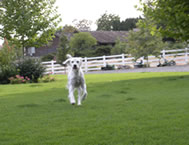 RLS is located at our home on
about four acres, in Hermiston, Oregon. Our dogs are indoor/outdoor dogs, and we pride ourselves on the care and attention they get. We raise and love our dogs how we expect our puppies to be raised--as family pets--included in daily life, with plenty of affection, toys, treats, chews, play, exercise, training, comfy beds, and more. RLS is located at our home on
about four acres, in Hermiston, Oregon. Our dogs are indoor/outdoor dogs, and we pride ourselves on the care and attention they get. We raise and love our dogs how we expect our puppies to be raised--as family pets--included in daily life, with plenty of affection, toys, treats, chews, play, exercise, training, comfy beds, and more.
The
dogs are never kenneled for longer than necessary. When we are home in the daytime, they are usually playing outside or indoors with us. If we are gone, they are safely kenneled. They interact constantly with each
other and with us, and someone is usually working or doing chores around the property with them (we spend a lot of time out there). During the summer, the dogs have a pool to keep cool
in, and on cold or wet days, they have a variety of dog blankets to wear. Other winter accommodations include heated water buckets, heat lights for any overnights in the kennels, and more indoor time. Our dogs have always gotten to spend time in our home with us and most of them are full time house dogs now. By no means are they stuck in kennels on their own until we can use them for hunting season; they are family. Our dogs' comfort, safety, health, and happiness are very important to us.
As far as the kennels we do have go, we use them we are absent, Each dog is
kept individually in a dog run on pea gravel with a well draining foundation of lime and crushed rock. We use pea gravel because it is soft and comfortable for the dogs and easy to clean. The powder coated kennels are set up on concrete frames to ensure long lasting panels, and each kennel has a bedded and heated doghouse,
a KennelDeck near the gate for lounging, and, of course, fresh water buckets. Every kennel also has a weather (and dog) safe outlet that can remain closed even when the dog houses and heated buckets are plugged in. There is overhead lighting with weather proof switches and exterior motion lighting. The attached insulated, heated room may serve as an indoor 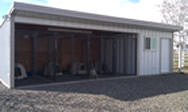 dog/whelping room but for now is our supply and feed room. The kennels are cleaned at least once
a day and are sterilized several times a year, or as needed, and waste
is also removed from the yards and graveled areas daily. In general, the dogs keep very neat kennels and wait to relieve themselves until they are turned out early in the mornings before work (on weekdays). Bedding and carpets
are washed on a regular basis, as are dog toys, buckets, bowls, feeders, etc. During the time spent
in kennels, the dogs are occupied with toys, chew treats, and Kongs as needed. dog/whelping room but for now is our supply and feed room. The kennels are cleaned at least once
a day and are sterilized several times a year, or as needed, and waste
is also removed from the yards and graveled areas daily. In general, the dogs keep very neat kennels and wait to relieve themselves until they are turned out early in the mornings before work (on weekdays). Bedding and carpets
are washed on a regular basis, as are dog toys, buckets, bowls, feeders, etc. During the time spent
in kennels, the dogs are occupied with toys, chew treats, and Kongs as needed.
For litters, we have used
a large whelping room that is located in the shop. It is an air-conditioned
and heated room with cabinets for storage and a screened window for more
ventilation. There is a 4x4' whelping box with pig rails placed in the room
for the dam and puppies,
and chairs and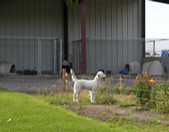 a cot for us. When the puppies are able to
get out of their box, the cement floor is covered with a non-slip surface.
The whelping room is kept very clean and puppy-proof. We provide them with lots of toys and obstacles for playtime and stimulation. The heated shop also
has a washroom, with plenty of storage, a deep sink that is
used to wash supplies and puppies, and a washer and dryer for towels,
dog bedding, dog wear, and litter supplies. Our only scruple with our whelping room setup is that it is confined, with no direct access for the dams/pups to the outside, which poses obvious problems. Ensuring the comfort of the dam (ie taking her outside for bathroom and play breaks) is another major reason why we spend so much time (read: live) with the litters in this room before they're weaned. This setup also requires us to maintain a strict and frequent cleaning/sanitation protocol for the health of a cot for us. When the puppies are able to
get out of their box, the cement floor is covered with a non-slip surface.
The whelping room is kept very clean and puppy-proof. We provide them with lots of toys and obstacles for playtime and stimulation. The heated shop also
has a washroom, with plenty of storage, a deep sink that is
used to wash supplies and puppies, and a washer and dryer for towels,
dog bedding, dog wear, and litter supplies. Our only scruple with our whelping room setup is that it is confined, with no direct access for the dams/pups to the outside, which poses obvious problems. Ensuring the comfort of the dam (ie taking her outside for bathroom and play breaks) is another major reason why we spend so much time (read: live) with the litters in this room before they're weaned. This setup also requires us to maintain a strict and frequent cleaning/sanitation protocol for the health of 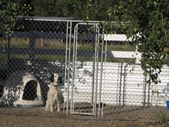 everyone involved. everyone involved.
For our future litters we may use the new kennel room as the whelping room, since it is attached to a run, and still large enough for us to stay in during their early weeks, or they may be raised in my (Chelsea's) home off the premises.
When the puppies are moved to the outside kennels for overnights and absenses, we make sure that they are extra safe with no/minimal places they might get stuck or hurt. During the day, they spend their time in our home, in a puppy pen in the yard, or more often, are let loose outside to explore under close supervision.
We will note that at this time about half of our dogs stay at Rick and Jan's Hermiston home, and half with me at my suburban home in Salem, Oregon. The dogs there stay loose or crated indoors when I am gone and have access to a large fenced backyard when I'm home. They often opt to stay inside with me and go outside (open door policy!) when there's something interesting to watch or chase (ie squirrels and birds). I have one large indoor/outdoor dog run, but we do not use it.
Nutrition
RLS places
a lot of value on adequate, balanced nutrition. Ongoing 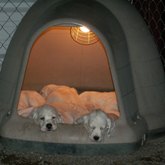 studying is always being done to ensure that we are always providing proper
diets. The foods we currently feed include Canidae Pure, Wishbone, and Taste of the Wild, supplemented with joint supplements, essential fatty acids, fresh raw and cooked foods, other higher quality foods from Fromm, Orijen, Earthborn, Petcurean, and Stella and Chewy's. We feel confident that what we are currently feeding is healthy and nutritious, and all of our dogs maintain excellent condition. studying is always being done to ensure that we are always providing proper
diets. The foods we currently feed include Canidae Pure, Wishbone, and Taste of the Wild, supplemented with joint supplements, essential fatty acids, fresh raw and cooked foods, other higher quality foods from Fromm, Orijen, Earthborn, Petcurean, and Stella and Chewy's. We feel confident that what we are currently feeding is healthy and nutritious, and all of our dogs maintain excellent condition.
Bred females
are fed a combination of a high energy diet and/or puppy food, plus added nutrients, and we supplement nursing mothers' meals with homecooked to make sure they are getting everything they need. During weaning, we make food mashes for the puppies that are mixed with Esbilac puppy formula.
Sometimes we add quality canned dog food in the transition. 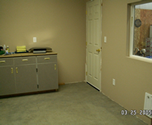
Our dogs are provided with a varietyof treats and chews, including raw meaty bones, antlers/horns, bully sticks, Himalayan chews, limited rawhide, stuffed frozen food toys, quality biscuits,
fresh sweet potato chips, carrots, homemade treats, etc. We look for chew treats that are made in the US and by natural processing. We also use high grade grain free kibbles and other chewy/jerky type treats for training and treat dispensor toys. Our buying guidelines  for those are similar to those for our food choices: made and sourced in the US, Ca, or NZ; extensive quality and safety control protocols; no unnamed meat or meal sources; no generic by-products; no artificial preservatives or dyes; and more. During the Summer, the dogs love garden fresh veggies
and frozen yogurt treats. Of course, when the farrier comes, the dogs get their much anticipated snack of horse hoof trimmings! for those are similar to those for our food choices: made and sourced in the US, Ca, or NZ; extensive quality and safety control protocols; no unnamed meat or meal sources; no generic by-products; no artificial preservatives or dyes; and more. During the Summer, the dogs love garden fresh veggies
and frozen yogurt treats. Of course, when the farrier comes, the dogs get their much anticipated snack of horse hoof trimmings!
Adult dogs are fed
once a day in the evening, weaned puppies are fed three to four times a day, and bred
bitches are fed at least twice a day. When inside our home, the dogs are just free fed or given food dispensing toys. RLS uses clean and durable plastic
buckets for water in most seasons and heated plastic buckets for winter.
The dogs’ water buckets are all kept clean and filled with fresh water.
Comprehensive Care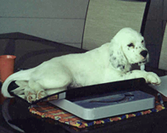
We feel that it is our great responsibility and privilege to learn as much as we can about health and veterinary issues. We're country people of ranching background, with good solid practical knowledge about animals. In addition, I (Chelsea) have a huge interest in veterinary medicine because of my involvement with animals and worked for almost two years as a veterinary technician. I have a Bachelor of Science degree in Zoology, so have studied in depth topics like genetics, microbiology, anatomy, physiology, and more. We see that the animals in our care maintain a high level of general health.
Everyone gets ample physical exercise and mental stimulation each day--both critical to happy, healthy dogs. They get free time outdoors to play and "hunt" for the critters around the properties, have a variety of interactive toys, and are generally included in our family, activities, and trips. We spend time engaging each one, each day, through play, training, and just plain loving on them. They also get to go with us on hikes and camping trips, to the Oregon Coast, around town on errands or events, on walks/runs in neighborhoods, cities, and parks, and more. Our lifestyle with them really lets us learn how handle and behave in a variety of situations, too, which is important because our puppies often go to homes where they are included in more than just hunting. A dog needs a solid temperament to be out in the real, modern world, and we get a deep understanding of our dogs' temperaments this way.
For veterinary care, our dogs are kept up to date with core and rabies
vaccinations, 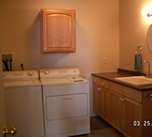 all given every three years after the initial puppy series. We de-worm the animals as needed, have our Willamette Valley dogs on heartworm prevention, check
them over daily, and keep them in clean, healthy environments. If a medical problem
is ever suspected, the dog makes a visit to our veterinary clinic and are treated appropriately--we don't skimp here! Pre-breeding clearances always included physical exams, brucellosis testing, OFA hip testing, and DNA testing, and in 2013, we decided to add CERF eye clearances and OFA thyroid and elbow testing. All of our dogs are microchipped for permanent identification. all given every three years after the initial puppy series. We de-worm the animals as needed, have our Willamette Valley dogs on heartworm prevention, check
them over daily, and keep them in clean, healthy environments. If a medical problem
is ever suspected, the dog makes a visit to our veterinary clinic and are treated appropriately--we don't skimp here! Pre-breeding clearances always included physical exams, brucellosis testing, OFA hip testing, and DNA testing, and in 2013, we decided to add CERF eye clearances and OFA thyroid and elbow testing. All of our dogs are microchipped for permanent identification.
Grooming
We always
make sure that our Llewellins are kept clean and well-groomed, for the
dogs’ benefits and ours. Grooming is an important part of their
health care because it 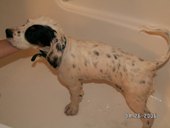 removes dead skin, loose hair, dirt, and debris.
Grooming also spreads the coats’ natural oils and increases blood
circulation. While our dogs' coats are pretty low maintenance, we brush the dogs as needed and keep their nails clipped, ears cleaned, etc. We give raw meaty bones for dental health. Adult dogs get bathed outside
or indoors as needed (depending on the weather), and the puppies are
bathed indoors as often as needed; we use soap-free, natural shampoos that are healthy for their skin and coat. Before each hunting season, our heavier coated dogs are trimmed short to avoid excessive weed tangles. (Because of the serious burrs, we also trim up the tails on some of the dogs.) removes dead skin, loose hair, dirt, and debris.
Grooming also spreads the coats’ natural oils and increases blood
circulation. While our dogs' coats are pretty low maintenance, we brush the dogs as needed and keep their nails clipped, ears cleaned, etc. We give raw meaty bones for dental health. Adult dogs get bathed outside
or indoors as needed (depending on the weather), and the puppies are
bathed indoors as often as needed; we use soap-free, natural shampoos that are healthy for their skin and coat. Before each hunting season, our heavier coated dogs are trimmed short to avoid excessive weed tangles. (Because of the serious burrs, we also trim up the tails on some of the dogs.)
Training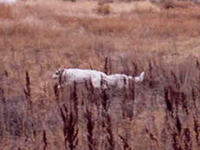
In the past here, training has been
pretty relaxed and informal, perhaps typical of an average owner. It began with extensive socialization, house training, manners,
and basic cues, such as come, sit, kennel, and stay. Within their first
year, daily interaction and non-stressful work paid off, and
the dogs also learned further basics like lay down, leave it, drink, out, and a couple
other easy commands. We didn't push our dogs too hard or
too fast; we tried to set the dogs up for success, make training lessons
frequent, quick, and positive, and use sense and patience. Successes and
attempts were rewarded, although for some things like heel and recall, we did use some mild corrections. For hunting, we really got by with teaching them recall, then just let them do their thing, learning naturally on wild game.
Then, there was a little detour as we went through a phase of trying to get into popular field training techniques, with plans of starting field trialing. To be honest, my heart wasn't in the training style, mentality, or methods enough to do much in that direction at that time, and I began to question it all. In 2009, I finally, fortunately, "discovered" marker training, which changed my life and our dogs' lives. I now incorporate this into our obedience (and other) training, and I am honing my skills and constantly reading and watching other trainers to incorporate it all into field training. This method of positive reinforcement is an exciting concept that has been utilized in other dog training for going on decades. Funny enough, before I initially tried to "educate" myself through gundog training, I'd actually used positive reinforcement fairly well in teaching some "tricks" as a child, but I now know marker training has a viable place in teaching "real" useful 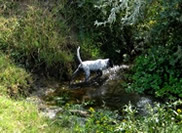 behaviors and skills for any dog sport, including upland hunting. We've already noticed how much more eager our dogs are to try new things and respond to cues, as well as an increase in the speed they learn. So, while we previously let wild birds and hunting situations do most of the training, I am excited and anxious to now be striving for "finished" dogs with positive training techniques that aren't based on fear, intimidation, force, or discomfort/pain. To attain such goals, we will be following LIMA (least invasive, minimally aversive) and the Humane Hierarchy principles. At that time, we will put our dogs AND our training methods to the test in trials, while continuing the ultimate test in wild bird hunting every year. behaviors and skills for any dog sport, including upland hunting. We've already noticed how much more eager our dogs are to try new things and respond to cues, as well as an increase in the speed they learn. So, while we previously let wild birds and hunting situations do most of the training, I am excited and anxious to now be striving for "finished" dogs with positive training techniques that aren't based on fear, intimidation, force, or discomfort/pain. To attain such goals, we will be following LIMA (least invasive, minimally aversive) and the Humane Hierarchy principles. At that time, we will put our dogs AND our training methods to the test in trials, while continuing the ultimate test in wild bird hunting every year.
We have used electronic
collars on our earlier dogs, after the dogs were trained, for proofing; however, they were not used during
the introduction of skills.These dogs do sometimes wear the electronic collars in the
field due to their training foundation. If used at 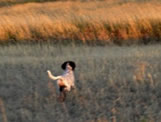 all, we most often use the vibration feature, rather than the shock, and at an appropriate level. We will not introduce puppies to electronic
collars, yet we will provide them with a solid foundation for learning without ever needing one. As mentioned above, since we are moving towards positive reinforcement in our field training, we will be going as far as possible with cue and skill building in our future dogs without an e-collar, and we are optimistic about not having to use them at all. all, we most often use the vibration feature, rather than the shock, and at an appropriate level. We will not introduce puppies to electronic
collars, yet we will provide them with a solid foundation for learning without ever needing one. As mentioned above, since we are moving towards positive reinforcement in our field training, we will be going as far as possible with cue and skill building in our future dogs without an e-collar, and we are optimistic about not having to use them at all.
Other than hunting and basic companion dog cues, our dogs are taught additional skills, according to what best suits their
personality and ability. I have expanded my training into skills needed for rally, freestyle, obedience, service, and fun tricks that build confidence and body awareness. Our dogs are not only
happy but also versatile and intelligent, and as always, they love their jobs no matter what we're asking them to do.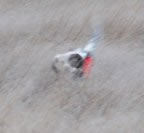
Wild Bird Hunting
It should come as no surprise that we hunt with our dogs and expect any dog we breed to outside our kennel to have extensive experience as well. During bird season,
we take our dogs out as often as possible to hunt wild game, mostly quail and pheasant in our region. Our dogs hunt singly
or in a brace on a variety of private farms and public lands. The terrain they handle ranges from desert grassland to lush alfalfa to rough cut corn fields, to challenging, rugged, basalt basins with rock, thorns, and thistles galore (and the occasional cacti) amidst the heavy brush. We usually hunt half or full days, in a range of weather conditions. Hardiness, stamina, scenting abilities, and agility are all very important in the areas we hunt. While we try to alternate them so that they all get to go out the same number of times, we do focus more on those that are still in the breeding program. Our main choice of game is pheasant and quail, but Llewellins will skillfully hunt any upland bird given the right exposure. (For instance, our pups hunt across the country on quail, pheasant, grouse, chukar, and more.) Each season is a fun and exciting time for us and our Llewellins, who know it's huntin' time when the leaves start falling.
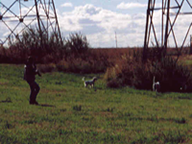 The dogs' safety and health is a top
concern in the field, and they are checked over throughout hunts. We make sure that the dogs do not get dehydrated, and if they get too beat up, we'll eventually pick them up, although they'd much prefer to continue working. Usually,
the dogs will wear protective gear, such as vests which has saved them multiple times from hidden barbed wire fences. While we do hunt on rough cut basalt, we haven't had to use boots, but would certainly consider them if/when necessary. Dog first aid kits
are always in the truck for added precaution. The dogs' safety and health is a top
concern in the field, and they are checked over throughout hunts. We make sure that the dogs do not get dehydrated, and if they get too beat up, we'll eventually pick them up, although they'd much prefer to continue working. Usually,
the dogs will wear protective gear, such as vests which has saved them multiple times from hidden barbed wire fences. While we do hunt on rough cut basalt, we haven't had to use boots, but would certainly consider them if/when necessary. Dog first aid kits
are always in the truck for added precaution.
All RLS dogs must have the experience of and talent for hunting, a temperament suitable for living with today's families, and be in excellent physical health confirmed by testing, or
they are not used for breeding. Click here for more info about our breeding program/goals.
Top |









 all given every three years after the initial puppy series. We de-worm the animals as needed, have our Willamette Valley dogs on heartworm prevention, check
them over daily, and keep them in clean, healthy environments. If a medical problem
is ever suspected, the dog makes a visit to our veterinary clinic and are treated appropriately--we don't skimp here! Pre-breeding clearances always included physical exams, brucellosis testing, OFA hip testing, and DNA testing, and in 2013, we decided to add CERF eye clearances and OFA thyroid and elbow testing. All of our dogs are microchipped for permanent identification.
all given every three years after the initial puppy series. We de-worm the animals as needed, have our Willamette Valley dogs on heartworm prevention, check
them over daily, and keep them in clean, healthy environments. If a medical problem
is ever suspected, the dog makes a visit to our veterinary clinic and are treated appropriately--we don't skimp here! Pre-breeding clearances always included physical exams, brucellosis testing, OFA hip testing, and DNA testing, and in 2013, we decided to add CERF eye clearances and OFA thyroid and elbow testing. All of our dogs are microchipped for permanent identification.




